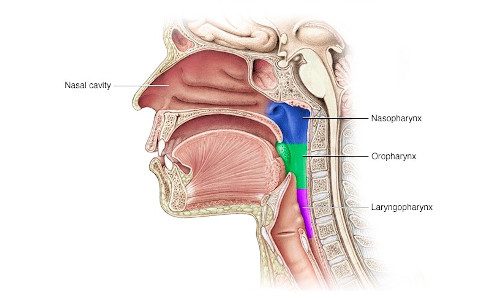Treatment
Surgery
The types of surgical procedures you may consider to treat your throat cancer depend on the location and stage of your cancer. Options may include:
- Surgery for early-stage throat cancer.Throat cancer that is confined to the surface of the throat or the vocal cords may be treated surgically using endoscopy. Your doctor may insert a hollow endoscope into your throat or voice box and then pass special surgical tools or a laser through the scope. Using these tools, your doctor can scrape off, cut out or, in the case of the laser, vaporize very superficial cancers.
- Surgery to remove all or part of the voice box (laryngectomy).For smaller tumors, your doctor may remove the part of your voice box that is affected by cancer, leaving as much of the voice box as possible. Your doctor may be able to preserve your ability to speak and breathe normally.
For larger, more-extensive tumors, it may be necessary to remove your entire voice box. Your windpipe is then attached to a hole (stoma) in your throat to allow you to breathe (tracheotomy). If your entire larynx is removed, you have several options for restoring your speech. You can work with a speech pathologist to learn to speak without your voice box.
- Surgery to remove part of the throat (pharyngectomy).Smaller throat cancers may require removing only small parts of your throat during surgery. Parts that are removed may be reconstructed in order to allow you to swallow food normally.
Surgery to remove more of your throat usually includes removal of your voice box as well. Your doctor may be able to reconstruct your throat to allow you to swallow food.
- Surgery to remove cancerous lymph nodes (neck dissection).If throat cancer has spread deep within your neck, your doctor may recommend surgery to remove some or all of the lymph nodes to see if they contain cancer cells.
Surgery carries a risk of bleeding and infection. Other possible complications, such as difficulty speaking or swallowing, will depend on the specific procedure you undergo.
Chemotherapy
Chemotherapy uses drugs to kill cancer cells.
Chemotherapy is often used along with radiation therapy in treating throat cancers. Certain chemotherapy drugs make cancer cells more sensitive to radiation therapy. But combining chemotherapy and radiation therapy increases the side effects of both treatments.
Discuss with your doctor the side effects you’re likely to experience and whether combined treatments will offer benefits that outweigh those effects.
Targeted drug therapy
Targeted drugs treat throat cancer by taking advantage of specific defects in cancer cells that fuel the cells’ growth.
As an example, the drug Cetuximab (Erbitux) is one targeted therapy approved for treating throat cancer in certain situations. Cetuximab stops the action of a protein that’s found in many types of healthy cells, but is more prevalent in certain types of throat cancer cells.
Other targeted drugs are available and more are being studied in clinical trials. Targeted drugs can be used alone or in combination with chemotherapy
Supportive (palliative) care
Palliative care is specialized medical care that focuses on providing relief from pain and other symptoms of a serious illness. Palliative care specialists work with you, your family and your other doctors to provide an extra layer of support that complements your ongoing care. Palliative care can be used while undergoing other aggressive treatments, such as surgery, chemotherapy or radiation therapy.
When palliative care is used along with all of the other appropriate treatments, people with cancer may feel better and live longer.
Palliative care is provided by a team of doctors, nurses and other specially trained professionals. Palliative care teams aim to improve the quality of life for people with cancer and their families. This form of care is offered alongside curative or other treatments you may be receiving.

